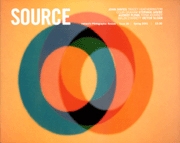Equivocation and Renewal
'Photogenic Drawing' by Martina Corry was at the Gallery of Photography, Dublin, November 8th - December 2nd 2000
Review by Siún Hanrahan
Issue 26 Spring 2001
View Contents ▸
Martina Corry's Photogenic Drawings exhibition offers the viewer surfaces in which areas of deep shadow dissolve into a pale undulating expanse, and soft shifting tones are punctuated by a busy crinkling. But, and this may be disconcerting in a photographic exhibition, there is no 'thing' for the viewer to see. No thing has had its likeness taken, there is no scene to be discerned through the photographs. There is only the photographic surface to attend to.
We are invited to appreciate the qualities of the photographic paper used. Its texture, tonal range, and layered structure - revealed where upper layers have been ruptured and plaited through creasing of the sheet. We are also invited - by the work and by its designation as 'photogenic drawing' - to appreciate the forms traced by means of the paper having been manipulated and exposed to light.
One of pieces I found particularly attractive was Wait. Activity, in the form of short horizontal creases, is focused along the side edges of the piece, with a calm central space darkening in tone toward its upper edge. Taking a cue from the title of the piece, this central space reads as a gap, the interval between moments of activity. On a more personal note, the soft billowing of the piece reminded me of a pillow so that the 'weight' became mine as I imagined sinking into this ambiguous space. This tactile temptation is amplified by the dense ruptures in the paper surface along the outer edges of the print. Noise 72 x 82 cm
Noise 72 x 82 cm
Several pieces within the exhibition explore a distinctly formal approach to mark making. One such piece is Noise in which six ruler- straight horizontal lines are drawn at regular intervals across the surface. The precision of the lines signals a purposeful intervention and yet the evenness of their disruption of the surface reduces the communicative potential of the pattern traced - it becomes 'ground' rather than 'figure'. As ground, the lines may be seen as anchoring the play of light from left to right across the surface or as a form of interference or noise distracting from that play as figure or signal.
Returning to the work's designation as 'photogenic drawing', this title evokes the time of photography's invention and a deep uncertainty as to how to characterise the processes involved. 'Photogenic' is a compound formed from the Greek words phos (light) and genesis (produced) and was coined by Henry Talbot in 1839. As Geoffrey Batchen argues in his book Burning With Desire, it was not clear at the time whether the processes involved were to be understood as actively making an image of nature or merely making it possible for nature to 'imprint an image of herself'. Thus we are asked to revisit 'the fundamentals' of photography.
Such fundamentals include issues raised by Corry's work such as activity and passivity, real and representation, and original and copy. In refusing us 'content' and returning attention to the surface of the photograph, Corry reveals the activity of photography (diverse factors involved in the making of photographs). And yet the process used also suggests a passive conception of photography. Light sensitive paper is manipulated so as to achieve a certain form, it is exposed to light, developed, fixed, and then straightened out and mounted. Thus the artifice of the camera is removed and the event represented and the representation become 'inextricably linked' - the photographic paper represents itself. Furthermore, a photogenic drawing is both the thing itself - the real - and its representation.
Turning again toward the work, I imagine the effort of folding the stiff sheet of photographic paper that has become Noise over and over on itself, and hear its explosive unfolding as it is released. I am impressed by the labour of flattening the various prints and the ruptures left in the surface by their earlier form. And I am reminded of ideas such as transience and permanence, absence and presence that have animated discussions of photography since the beginning. A fleeting moment in the history of this sheet of paper - when it had a sculptural presence - is preserved through its self-portrait. Each of the drawings is thus a record of a moment in time and we are simultaneously confronted with both 'past' and 'present'.
The answers offered by Corry's work to questions regarding the nature of photography, like those of the first photographers invoked by her title, are equivocal. On the one hand the work reveals photography as an active making of images, as artifice. On the other hand, the work seeks to avoid the artificial and allow nature or 'the event' to imprint itself, so that photography is revealed as a passive taking of images. The challenge posed by this equivocation to comfortable dichotomies such as modern/postmodern is stimulating and quickens the serene delicacy of the prints.
And so I am puzzled by the place of the Aluminium Foil Series within this exhibition. My difficulty is not that they are photographs rather than photograms or photogenic drawings. It is that beautiful as this set of three images undoubtedly is they seem to fall back on an uninflected tale of surfaces, and a modernist renewal of vision.
Other articles by Siún Hanrahan:
Other articles mentioning Martina Corry:
Other articles on photography from the 'Conceptual' category ▸






